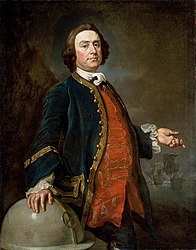File:Commodore George Walker (before 1700-1777) RMG BHC4247.jpg

Original file (962 × 1,208 pixels, file size: 1.12 MB, MIME type: image/jpeg)
Captions
Captions
Summary[edit]
| anonymous: Commodore George Walker (before 1700-1777)
|
||||||||||||
|---|---|---|---|---|---|---|---|---|---|---|---|---|
| Artist | ||||||||||||
| Author |
British school, 18th century |
|||||||||||
| Title | ||||||||||||
| Object type |
painting object_type QS:P31,Q3305213 |
|||||||||||
| Genre |
portrait |
|||||||||||
| Description |
English: Commodore George Walker (before 1700-1777) A three-quarter length portrait of the famous privateersman George Walker. He wears a blue jacket with gold braiding and buttons, red waistcoat, necktie and brown wig. Walker is shown standing in front of a rock and gesturing with his left hand towards a sea action taking place in the distance on the right. His right hand rests on a globe just above a partly legible inscription ‘F…… Gib…l…C. St. Vin’. This portrait probably commemorates one of Walker’s successful actions capturing a Spanish treasure ship, the ‘Glorioso’, near Cape St Vincent. He had command of the ‘King George’, a 32-gun frigate which formed part of a squadron of four privateers ‘King George’, ‘Prince Frederick’, ‘Duke’, and ‘Princess Amelia’. Collectively known as the Royal Family, they had been cruising for nearly a year and made considerable prize money. In July 1747 they sailed from Lisbon and on 6 October sighted the 70-gun Spanish ship ‘Glorioso’ heading for Cape St Vincent. Guessing that she was laden with treasure, Walker attacked. After an action lasting several hours the ‘Glorioso’ was finally captured by another ship, the ‘Russell’ and escorted into Tagus under Walker’s guidance. It is probably this event which is shown in the painting. Walker is generally regarded as the most successful British privateer. A resourceful and innovative seaman, he always carried musicians on board, and cared for his crews who in their turn respected him. Very little is known of his subsequent life, though the syndicate that owned the Royal Family did not honour their debts to him and he was imprisoned and then declared bankrupt. He died on 20 September 1777 at Seething Lane, in the City of London, and was buried at All Hallows Barking, Great Tower Street, London. |
|||||||||||
| Date |
circa 1750 date QS:P571,+1750-00-00T00:00:00Z/9,P1480,Q5727902 |
|||||||||||
| Medium |
oil on canvas |
|||||||||||
| Dimensions | Painting: 1290 mm x 1020 mm; Frame: 1562 mm x 1315 mm x 100 mm | |||||||||||
| Collection |
institution QS:P195,Q7374509 |
|||||||||||
| Current location | ||||||||||||
| Accession number |
BHC4247 |
|||||||||||
| Notes | This object was sighted as being on display during the Collections Inventory Project (2001-2005). It will need to be checked for object numbers and its condition activity updated | |||||||||||
| References | ||||||||||||
| Source/Photographer | http://collections.rmg.co.uk/collections/objects/201229 | |||||||||||
| Permission (Reusing this file) |
The original artefact or artwork has been assessed as public domain by age, and faithful reproductions of the two dimensional work are also public domain. No permission is required for reuse for any purpose. The text of this image record has been derived from the Royal Museums Greenwich catalogue and image metadata. Individual data and facts such as date, author and title are not copyrightable, but reuse of longer descriptive text from the catalogue may not be considered fair use. Reuse of the text must be attributed to the "National Maritime Museum, Greenwich, London" and a Creative Commons CC-BY-NC-SA-3.0 license may apply if not rewritten. Refer to Royal Museums Greenwich copyright. |
|||||||||||
| Identifier InfoField | Acquisition Number: OP1993-3 id number: BHC4247 |
|||||||||||
| Collection InfoField | Oil paintings | |||||||||||
Licensing[edit]
|
This is a faithful photographic reproduction of a two-dimensional, public domain work of art. The work of art itself is in the public domain for the following reason:
The official position taken by the Wikimedia Foundation is that "faithful reproductions of two-dimensional public domain works of art are public domain".
This photographic reproduction is therefore also considered to be in the public domain in the United States. In other jurisdictions, re-use of this content may be restricted; see Reuse of PD-Art photographs for details. | |||||
File history
Click on a date/time to view the file as it appeared at that time.
| Date/Time | Thumbnail | Dimensions | User | Comment | |
|---|---|---|---|---|---|
| current | 15:01, 1 October 2017 |  | 962 × 1,208 (1.12 MB) | Fæ (talk | contribs) | Royal Museums Greenwich Oil paintings (1750), http://collections.rmg.co.uk/collections/objects/201229 #1983 |
You cannot overwrite this file.
File usage on Commons
The following page uses this file:
Metadata
This file contains additional information such as Exif metadata which may have been added by the digital camera, scanner, or software program used to create or digitize it. If the file has been modified from its original state, some details such as the timestamp may not fully reflect those of the original file. The timestamp is only as accurate as the clock in the camera, and it may be completely wrong.
| JPEG file comment | File written by Adobe Photoshop¨ 4.0 |
|---|

